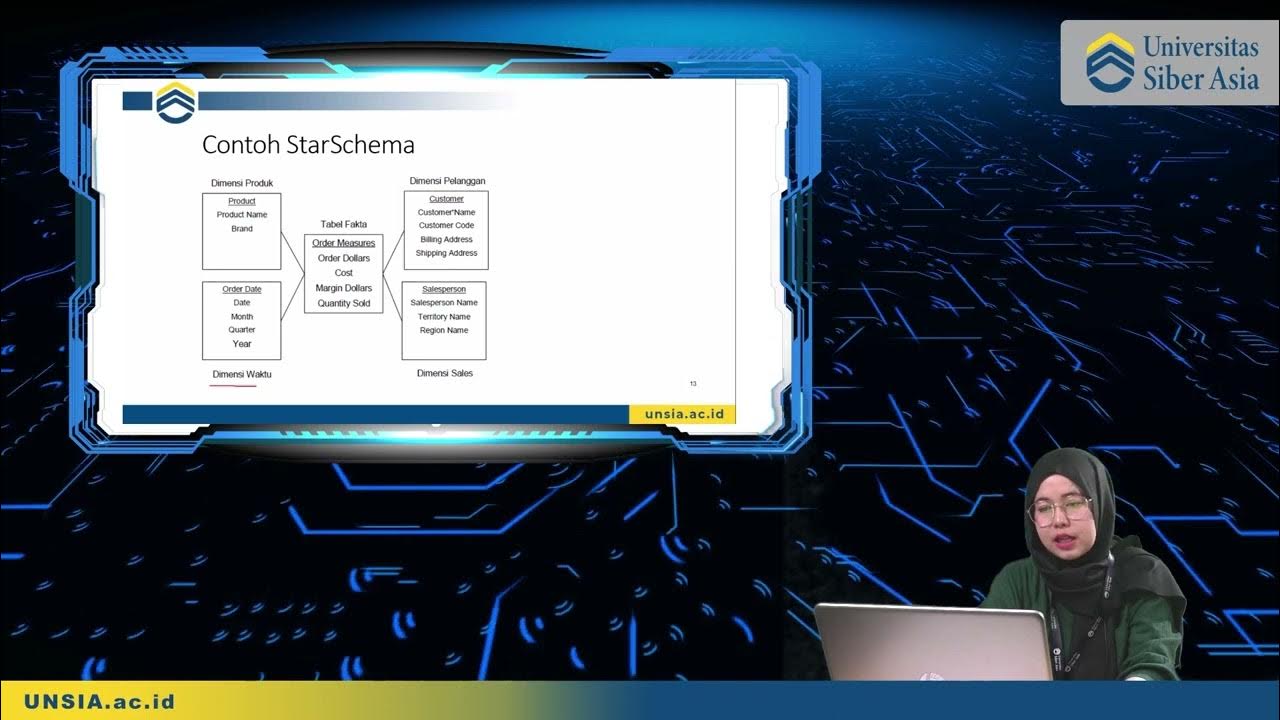Kuliah Data Warehouse & Data Mining - 01. Konsep Data Warehouse
Summary
TLDRIn this lecture on Data Warehousing, Adi Muhammad introduces the fundamental concepts of data warehouses and data mining. He explains the definition, characteristics, architecture, and motivations behind building a data warehouse. The focus is on how data from various sources is integrated and stored for efficient analysis. The lecture covers key aspects such as subject-oriented, time-variant, non-volatile data, and how these features support decision-making processes. Additionally, the importance of quality data, challenges in building a data warehouse, and its applications in various industries are discussed, with an emphasis on the growing demand for data engineering professionals.
Takeaways
- 😀 The course on Data Warehouse and Data Mining introduces the concept of Data Warehousing, focusing on the structure and processes behind it.
- 😀 The grading system is divided into 10% attendance, 30% assignments, and 30% final exams, with a 75% attendance requirement to take exams.
- 😀 Data Warehousing involves collecting and processing data into a form suitable for analysis, with an emphasis on Data Mining techniques.
- 😀 Data Warehouses are defined as subject-oriented, integrated, time-variant, and non-volatile collections of data that support decision-making.
- 😀 Inmon defines a Data Warehouse as a system that stores integrated, time-variant data for management decision-making, without frequent updates.
- 😀 Kimball defines a Data Warehouse as a database designed for transaction analysis, with focus on querying and supporting decision-making systems like DSS and EIS.
- 😀 Key characteristics of Data Warehouses include being subject-oriented, integrated, having a time series format, and being non-volatile (no updates after data is entered).
- 😀 Data Warehouses integrate data from various business areas, ensuring consistency across different systems for more efficient decision-making.
- 😀 The architecture of a Data Warehouse involves collecting data from both internal and external sources to support various business functions and decision support systems.
- 😀 The main motivations for developing a Data Warehouse are to handle large queries, ensure data consistency, reduce operational costs, and improve decision-making efficiency.
- 😀 Challenges in building Data Warehouses include the need for skilled professionals (Data Engineers), handling increasing data volume, and ensuring effective metadata and data mining processes.
Q & A
What is the primary focus of the course being discussed in the script?
-The primary focus of the course is to teach the concepts of Data Warehousing and Data Mining, including the development and implementation of Data Warehouses, as well as techniques in Data Mining for analysis purposes.
How is the grading for the course structured?
-The grading is divided into attendance (10%), assignments (30%), and the final exam (30%). Attendance requires a minimum of 75% to be eligible for midterm and final exams.
What are the key characteristics of a Data Warehouse?
-The key characteristics of a Data Warehouse include being subject-oriented, integrated, time-variant (with historical data), and non-volatile (with no updates to the data once stored).
How does a Data Warehouse differ from OLTP (Online Transaction Processing)?
-A Data Warehouse stores historical data that is non-volatile and used for analysis, whereas OLTP systems handle real-time transaction data that is constantly updated.
What is meant by 'subject-oriented' in a Data Warehouse?
-Subject-oriented means that the data in a Data Warehouse is organized around key business subjects or entities, such as customers, products, or sales, rather than focusing on individual transactions.
Why is data integration important in a Data Warehouse?
-Data integration ensures that data from different systems within an organization, such as sales and production, is connected and stored in a unified manner, allowing for comprehensive analysis and decision-making.
What does 'time-variant' mean in the context of a Data Warehouse?
-'Time-variant' refers to the fact that Data Warehouses store historical data over time, with each piece of data tied to a specific point in time, allowing for trend analysis and long-term insights.
What is the significance of non-volatility in a Data Warehouse?
-Non-volatility means that once data is stored in the Data Warehouse, it cannot be updated, ensuring that historical data remains intact and unchanged for future analysis.
What are the key motivations for building a Data Warehouse?
-The motivations for building a Data Warehouse include improving query performance, integrating inconsistent and disparate data sources, reducing costs related to data retrieval, and supporting decision-making processes through accurate, consistent data.
What challenges are faced when building and managing a Data Warehouse?
-Challenges include the need for skilled professionals like data engineers or architects, managing increasing data volume, ensuring proper data mining, and handling metadata for effective data processing and decision support.
Outlines

Dieser Bereich ist nur für Premium-Benutzer verfügbar. Bitte führen Sie ein Upgrade durch, um auf diesen Abschnitt zuzugreifen.
Upgrade durchführenMindmap

Dieser Bereich ist nur für Premium-Benutzer verfügbar. Bitte führen Sie ein Upgrade durch, um auf diesen Abschnitt zuzugreifen.
Upgrade durchführenKeywords

Dieser Bereich ist nur für Premium-Benutzer verfügbar. Bitte führen Sie ein Upgrade durch, um auf diesen Abschnitt zuzugreifen.
Upgrade durchführenHighlights

Dieser Bereich ist nur für Premium-Benutzer verfügbar. Bitte führen Sie ein Upgrade durch, um auf diesen Abschnitt zuzugreifen.
Upgrade durchführenTranscripts

Dieser Bereich ist nur für Premium-Benutzer verfügbar. Bitte führen Sie ein Upgrade durch, um auf diesen Abschnitt zuzugreifen.
Upgrade durchführenWeitere ähnliche Videos ansehen

Data Warehouse Interview Questions And Answers | Data Warehouse Interview Preparation | Intellipaat

Pertemuan 1 - Pengantar Data Mining | Kuliah Online Data Mining 2021 | Data Mining Indonesia

Pertemuan 5 - ICT Literacy - Cian Ramadhona Hassolthine, S.Kom., M.Kom

Introduction To DBMS

Data Mining Foundations Eps-01 Apa itu Data Mining?

What Is a Data Warehouse?
5.0 / 5 (0 votes)
